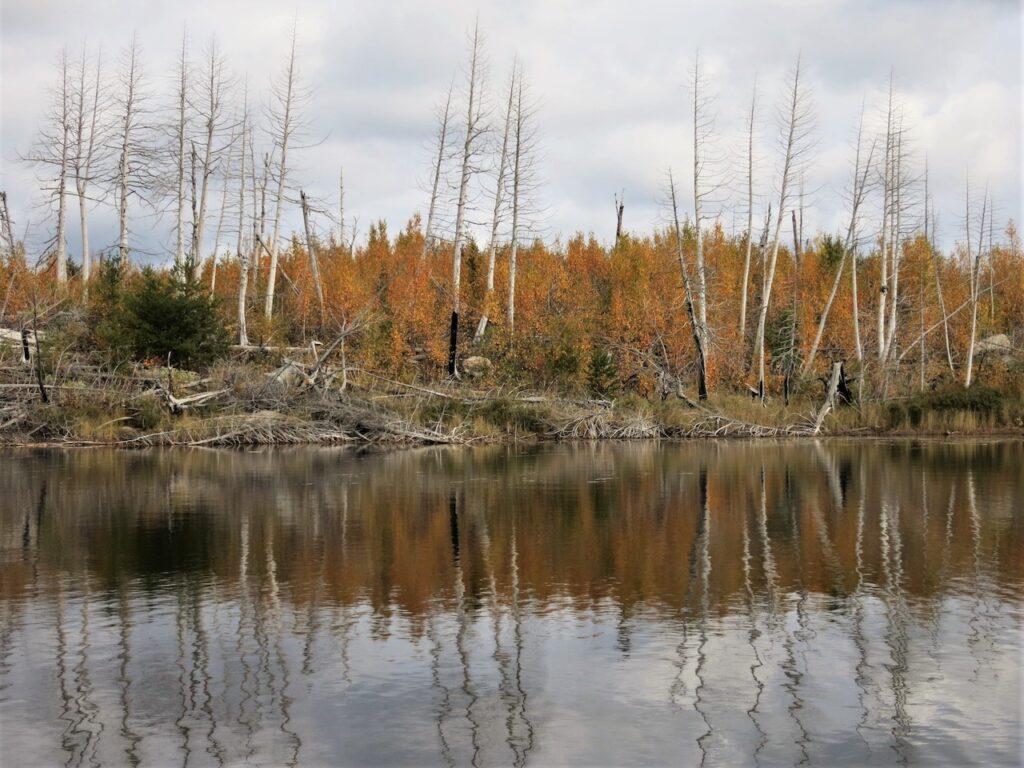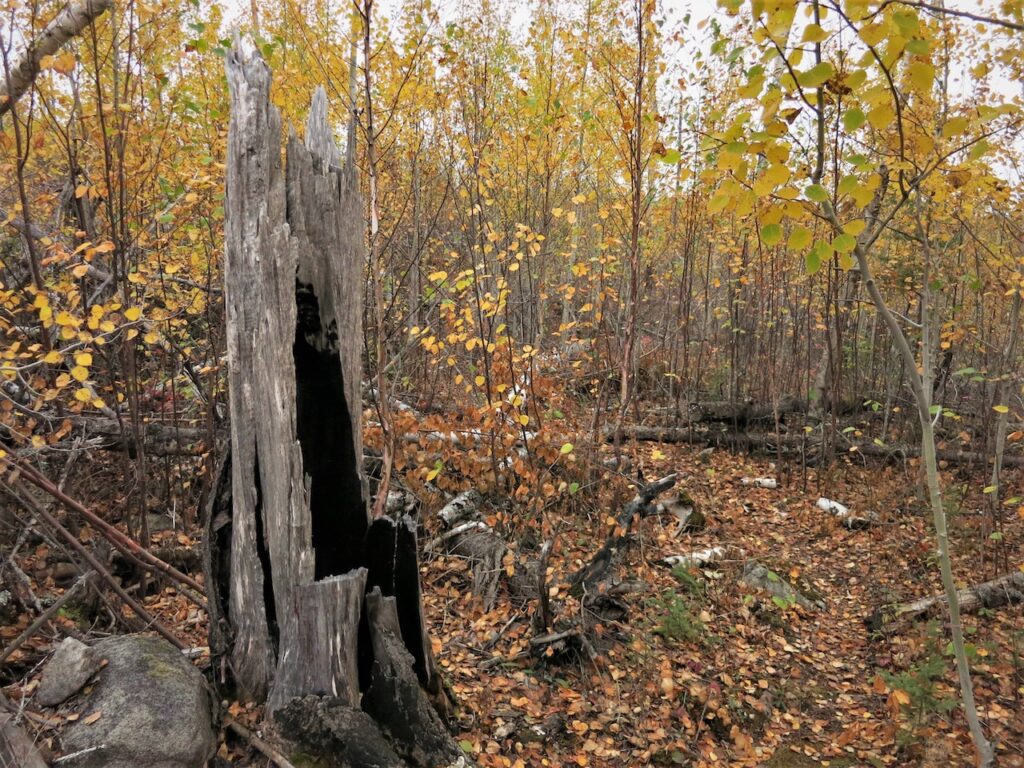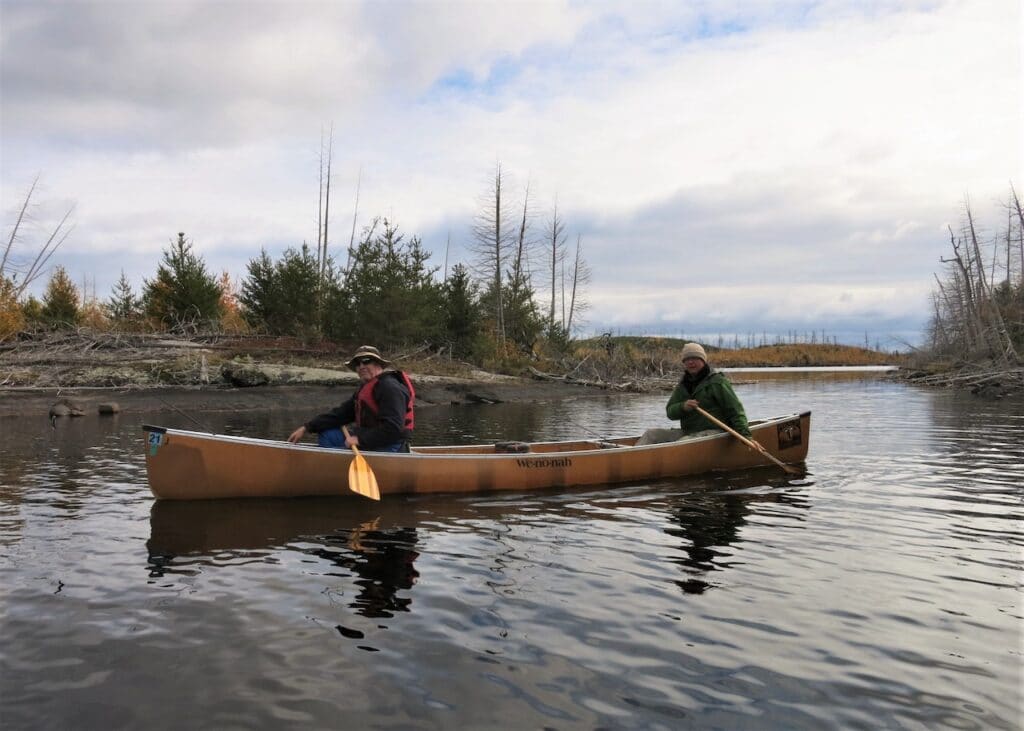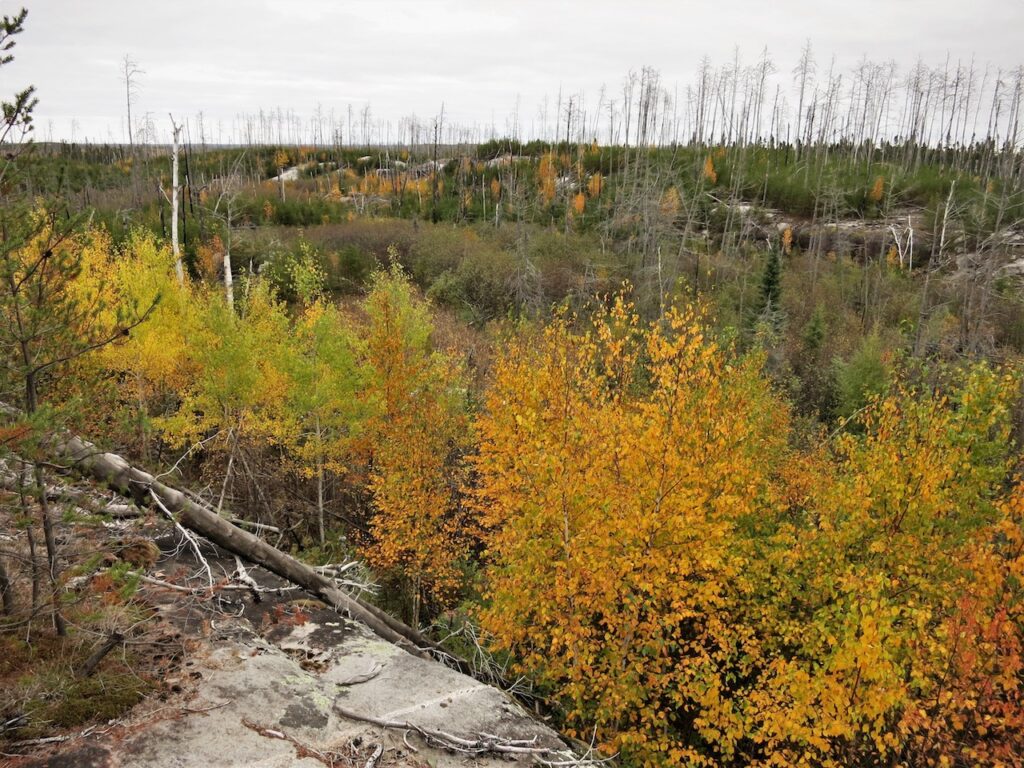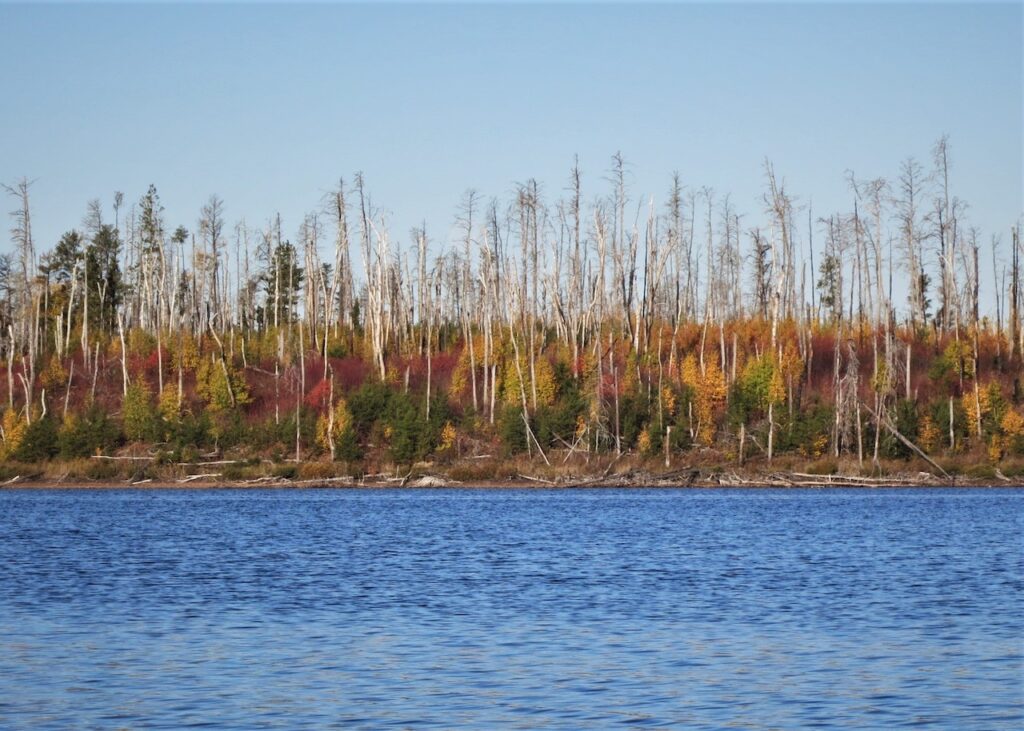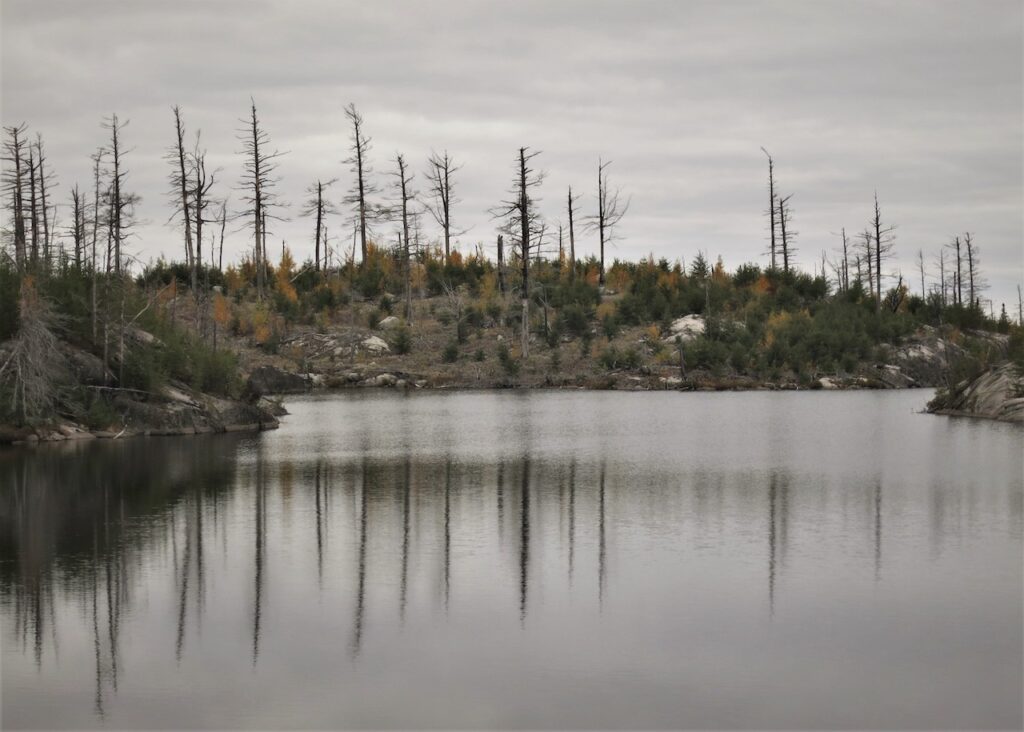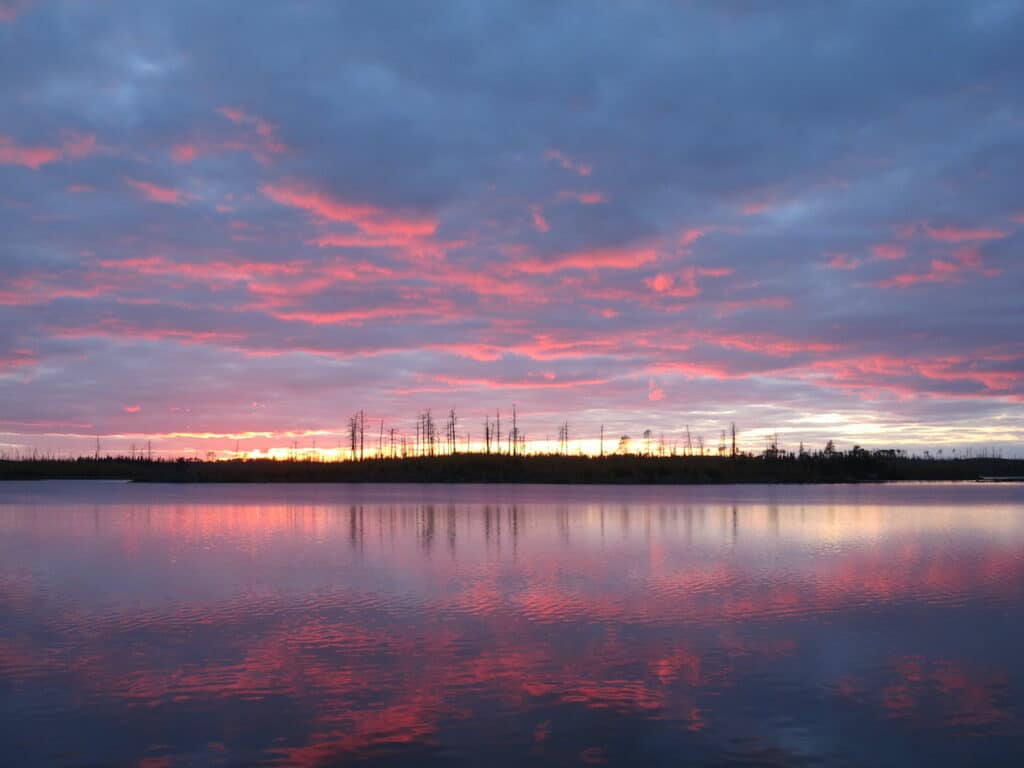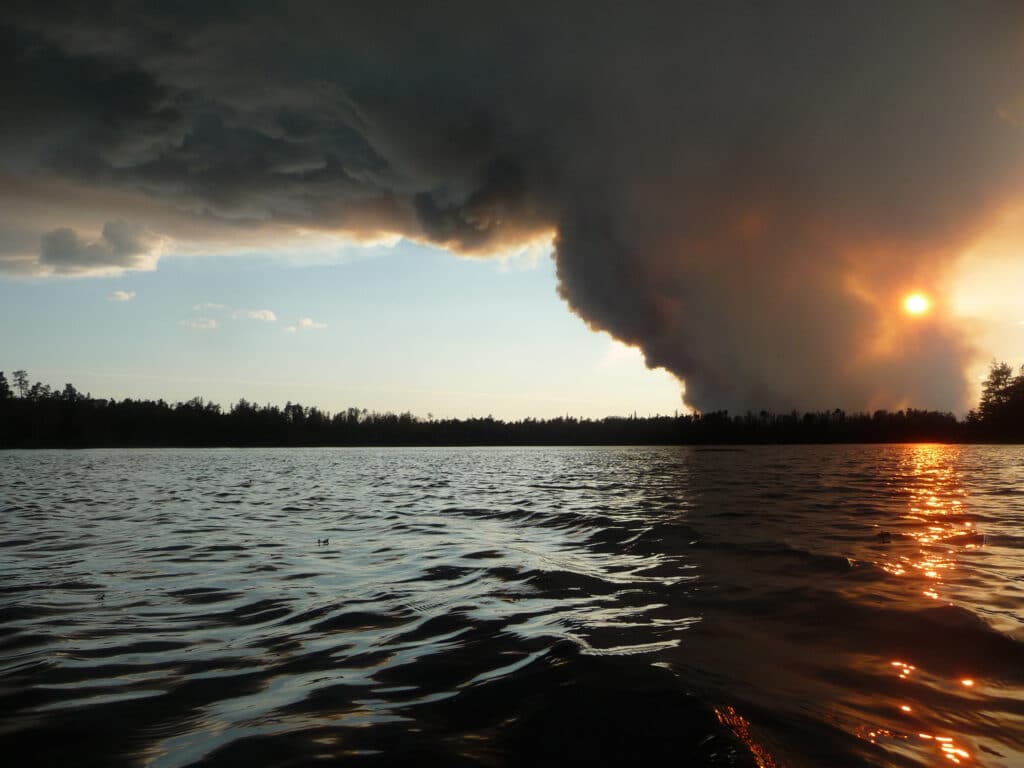
Ten years ago this week, people in northern Minnesota were recovering from a fearsome experience: the explosive Pagami Creek Fire. The blaze ended up burning 93,000 acres, almost entirely in the Boundary Waters Canoe Area Wilderness. On September 12, it ran about 16 miles west, pushed by powerful winds, putting several Forest Service rangers as well as some wilderness visitors in harm’s way.
It was one of the largest fires in Minnesota history, and raised fears for people and property inside and outside the Boundary Waters.
As the flames finally fizzled out, much of the attention went elsewhere. But while Pagami Creek marked the end of one forest, it was the beginning of another.
Boreal forests like that in the Boundary Waters are made to burn, it provides a fresh chance for new life. Occasional fires can also prevent more dangerous fires, creating a patchwork of different forest types that will contain and slow blazes. Fires can also “reset the clock” creating more diverse habitat for wildlife.

A year after the fire the landscape was still mainly charred with signs of greening. Ten years later, the shorelines are almost entirely green, with deciduous trees gaining on the remains of burned conifers. “This is what the system is supposed to do after fires, and even hot fires,” Patty Johnson, zone fire manager for the east side of the Superior National Forest, told MPR News. “It’s lush. And it’s because the fire came through, which puts nitrogen back into the soils, opens up the sites for the seeds to really take off, and knocks back all of the other brush and competing vegetation.”
But fires are few in much of the forest. Analysis after the Pagami Creek Fire showed that the Forest Service had put out about 50 fires in the area where the inferno later consumed 93,000 acres. The fire grew to a dangerous length, creating an east-facing front that was easily propelled by west winds, in areas of forest that had been spared when the Forest Service extinguished another fire in 2006.
There’s a saying that “nature bats last.” The forest was fated to burn, and fortunately there was no loss of life and nothing was destroyed that couldn’t be replaced. (Six wilderness rangers had a very close call on Lake Insula.) But once the fire finally came and went, nature knew what to do. In waves of growth, the landscape greened gradually, and is continuing to shift as trees grow and age.
Regeneration can happen slowly and, in the wilderness, largely out of sight. But in the past 10 years, some have been lucky enough to observe the process.
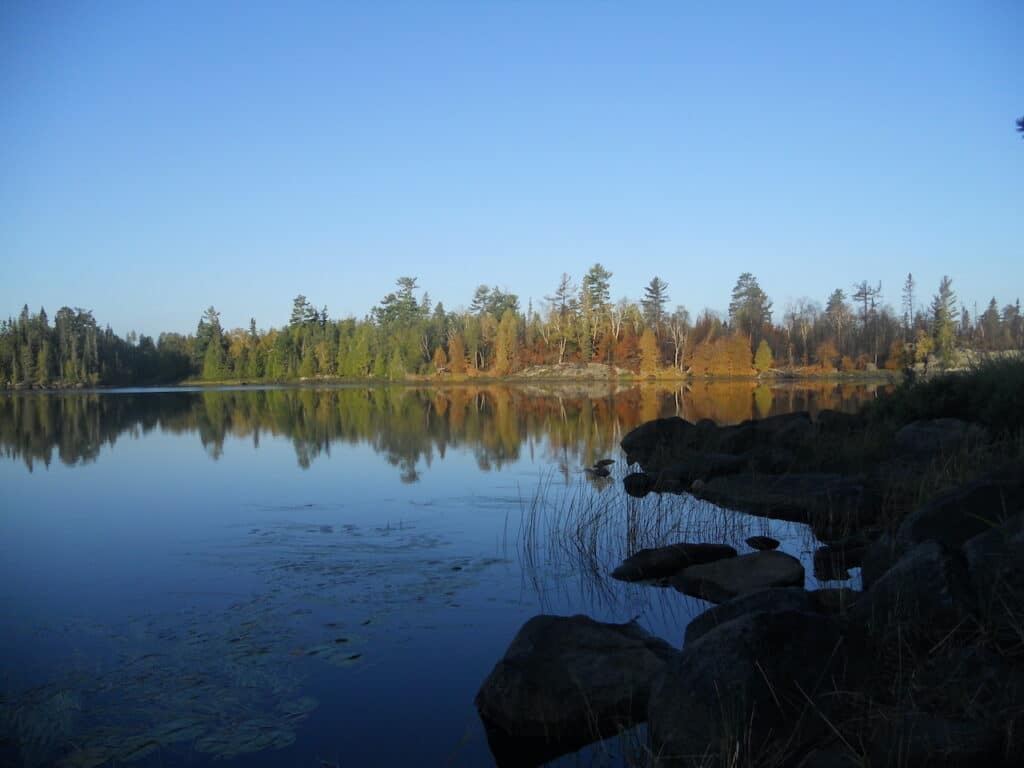
Quetico Superior Wilderness News readers and past contributors Norma and Larry Christianson were camped on Lake Three in September 2011 when the Pagami Creek Fire forced them to flee. They spent a nervous night in the wilderness before exiting safely.
“With adrenaline running big time, we paddled away from the flames and around a few small islands out into the open lake and two miles north in the wind and smoky twilight, before arriving at the Forest Service recommended overnight area on a small peninsula where Lake Three gives way to Lake Four very near the well known ‘Diamond Rock’ landmark.
“We settled in for a long night of windblown smoke on fire watch from our little red camp chairs snuggled into a cozy, sheltered area of small pine and cedar trees overlooking the water of both lakes. A double escape route – either east onto Lake Four or west onto Lake Three if the wind shifted and drove the flames northward.”
– Larry Christianson, “Abandon Camp!” December 2012
In the intervening years, they have returned to the lake often, sometimes more than once a year. It has allowed them to watch the woods gradually grow back. They just returned from this year’s trip to Lake Three. The plans were almost canceled by closures related to fires this summer.
The Christiansons have shared some of their photos and observations from this past decade. The text are excerpts from Larry’s journals, while the photos were taken by Norma.
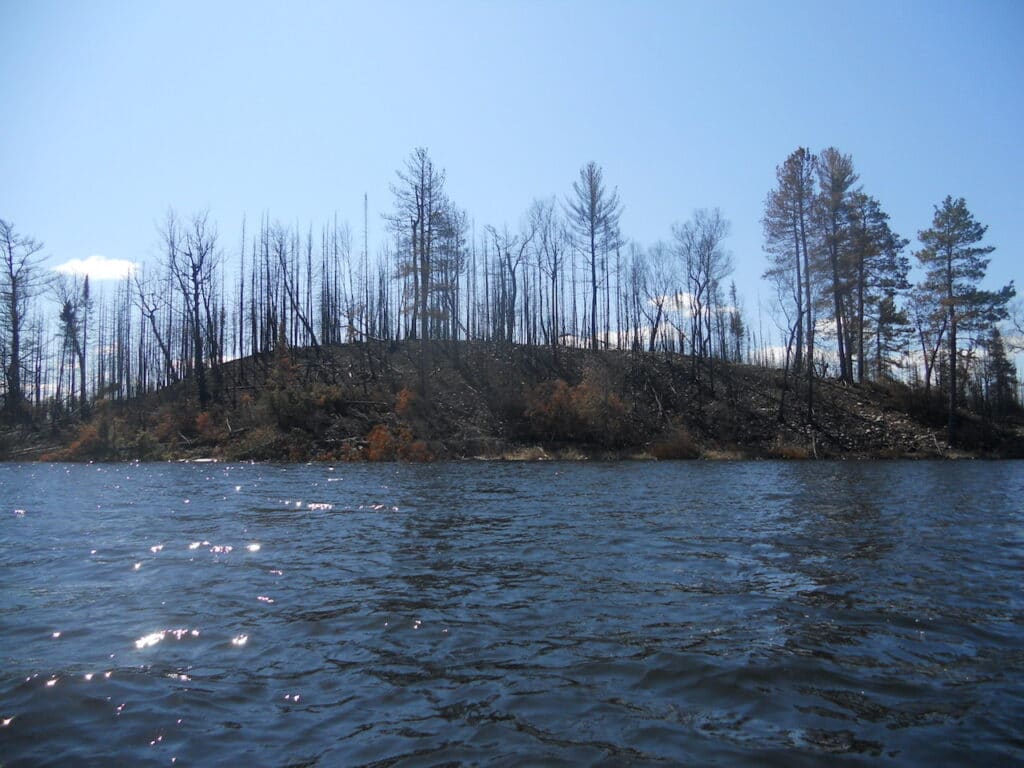
April 2012
“An early ice out brought Norma and I into the Boundary Waters the last week of April for our first look at fire damage just seven months after our hasty departure. It was like gliding along into the fire zone. Our first signs of burnt trees appeared near the portage on the east end of Lake One. More evidence on Lake Two with dramatic scenes of scorched forest all the way to the shoreline as we approached the passageway area leading into Lake Three. Exposed boulders littered hillsides barren of anything but mushy ash, toppled trees and charred snags standing in wait for a windy farewell sometime in the next moments or decades.
“On Lake Three the fire damage was erratic and intermittent, with the most extensive burned areas along the southern shore and through the narrow channel on the east side of the lake. Awe-struck would be an accurate description of our thoughts and feelings as we paddled around the lake taking photos and checking on campsites. A quiet hush settled deep into our hearts and spirits. Words seemed like an unnecessary intrusion.
“To our great surprise, our island campsite (#10) was spared. No burn damage, although a nearby island to the west was severely burned and blackened to a crisp, except for a large red pine tree where an eagle’s nest has long been located. No change since our hasty departure last Fall. Our wood pile was still stacked neatly by the fire grate, but the wire fish basket we left tied to a rock on the shoreline when loading the canoe upon evacuation was nowhere to be found. With flames in sight, ashes raining from the sky and smoke thickening, leave no trace wilderness camping failed to capture our full attention.
“Seven months after a major forest fire, we were witnesses to the changing faces of natural beauty and forest renewal in a wilderness landscape marked by dramatic contrasts. The post-fire panorama of Lake Three bears an inspiring witness to a pattern of natural diversity in shades of glorious green and burned black. Aging and regeneration of forest communities blending together in a dynamic present and a hopeful future.”
– Larry Christianson
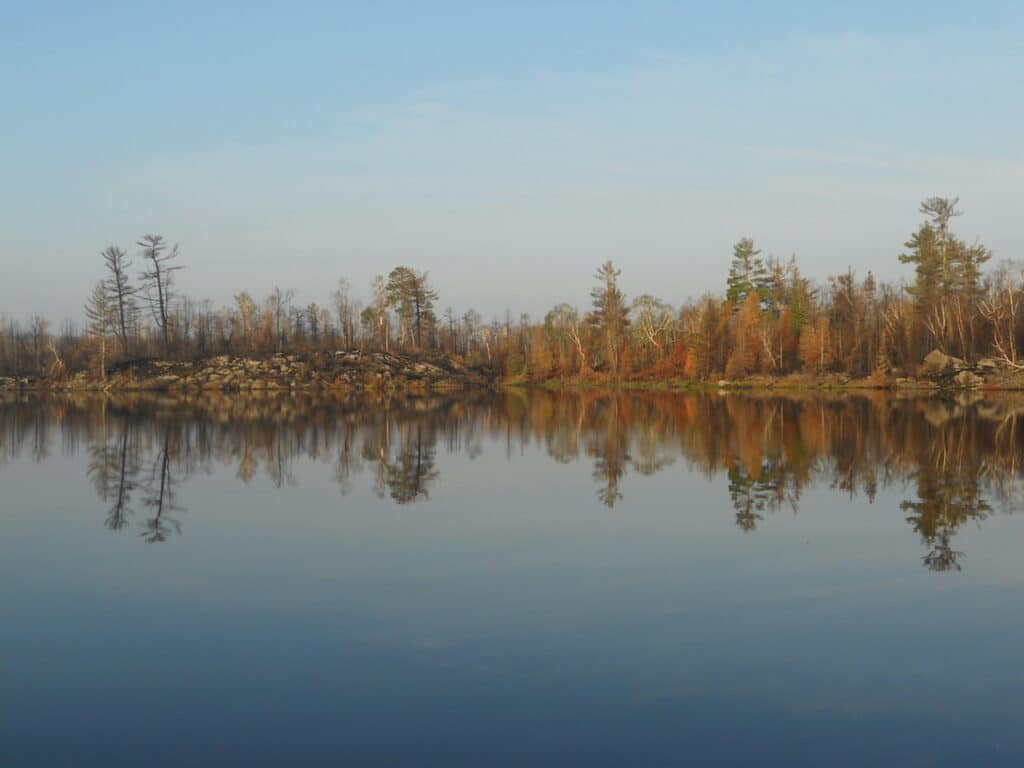
June 2012
“Back on Lake Three we camped at our island campsite (#10), untouched by fire in the midst of nearby islands and shorelines scorched to bedrock, and already showing tender shoots of green plants and delicate wild flowers sprouting through thick blankets of black ash and around charred snags and fallen trees. It was an inspiring display of nature in renewal mode. New life emerging from old destruction and death. The birth pangs of forest revitalization happening before our eyes.”
– Larry Christianson
September 2013
“We paddled along the south shore of Lake Three and around the islands checking out extensive fire damage and a few burned out campsites. Awesome sights of destruction and the beginning stages of forest renewal, as well as refreshing our memories with how close we really were to the towering flames as they raced along the south shore on that fateful evening two years back. Huge boulders burned black offered a stark message about the nature of beauty and the timelessness of the natural world.”
– Larry Christianson
July 2014
“Near the rapids at the east end of Lake Four, the new reality landscape looked like an inferno roared through, leaving a haphazard tangle of destruction in its long wake. Fireweed dominated the scene along with countless other weeds, mosses, and saplings of pine, birch and aspen. The scene presented visible witnesses to forest renewal, to hope on horizon of ugliness and beauty blending together in a natural fabric of wilderness surviving and thriving. Everything was changed except the water and aquatic life carrying on beneath the surface.
“Our wild blueberry picking evolved into a bonanza as our timing coincided with the first wave of ripeness. The island where we were camping was loaded with blueberry plants, as was a nearby rocky, open area. In this third growing season following the forest fire, blueberries were making a remarkable comeback, sprouting fourth out of ash enriched soil in a textbook case causing me to wonder how long before bears would return to the area.”
– Larry Christianson
August 2014
“While camped on the east end of Lake Four, we visited a few locations totally burned in the forest fire of 2011. At the area surrounding the rapids, new growth is an incredible witness to forest renewal and the resiliency of creation, as well as the relentless reality of destruction. It is nothing less than a living laboratory offering countless science lessons for decades to come. Norma took photos to match some of the scenes she had taken pictures in years before the fire as a part of her visual documentary of landscape change.”
– Larry Christianson
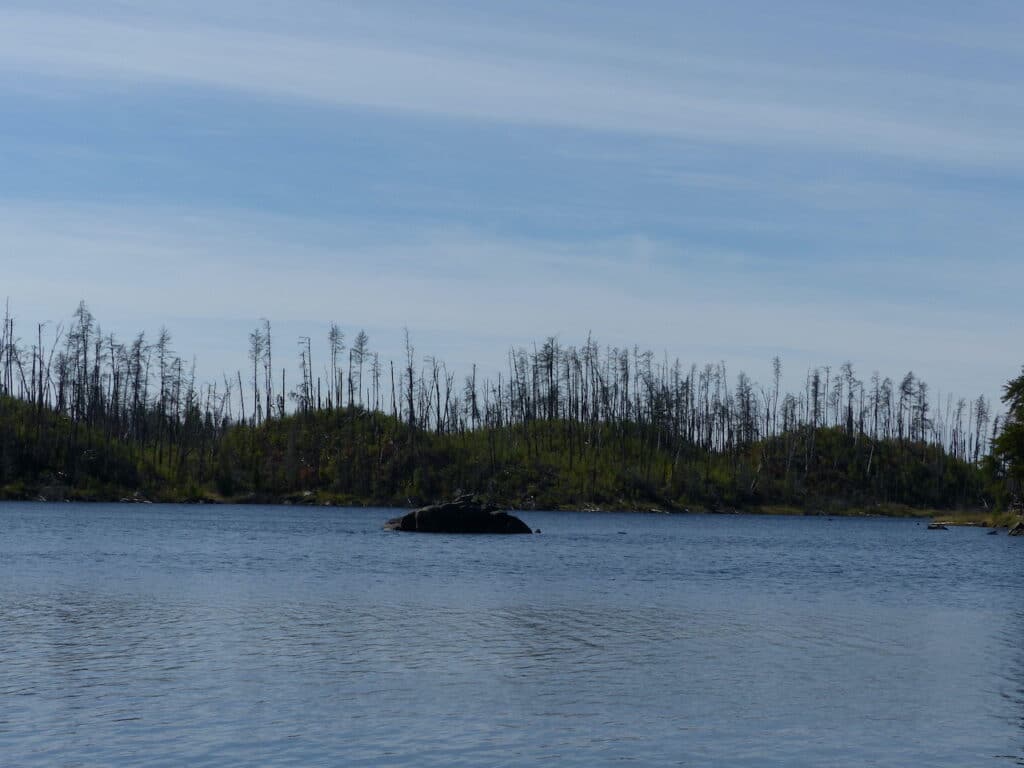
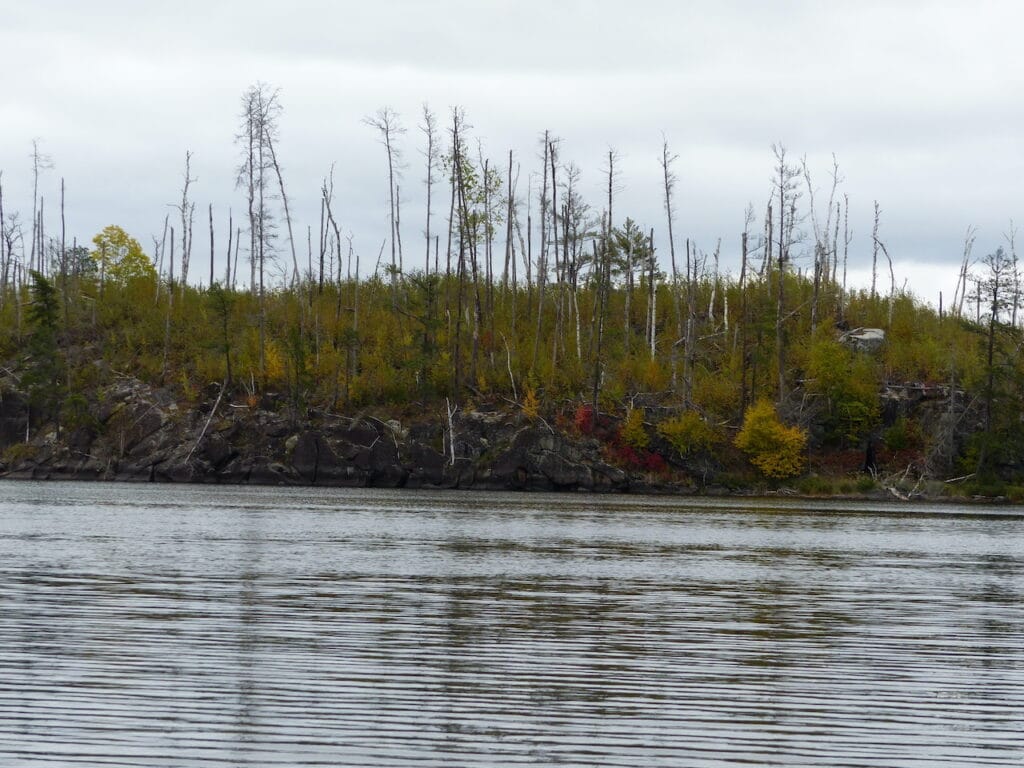
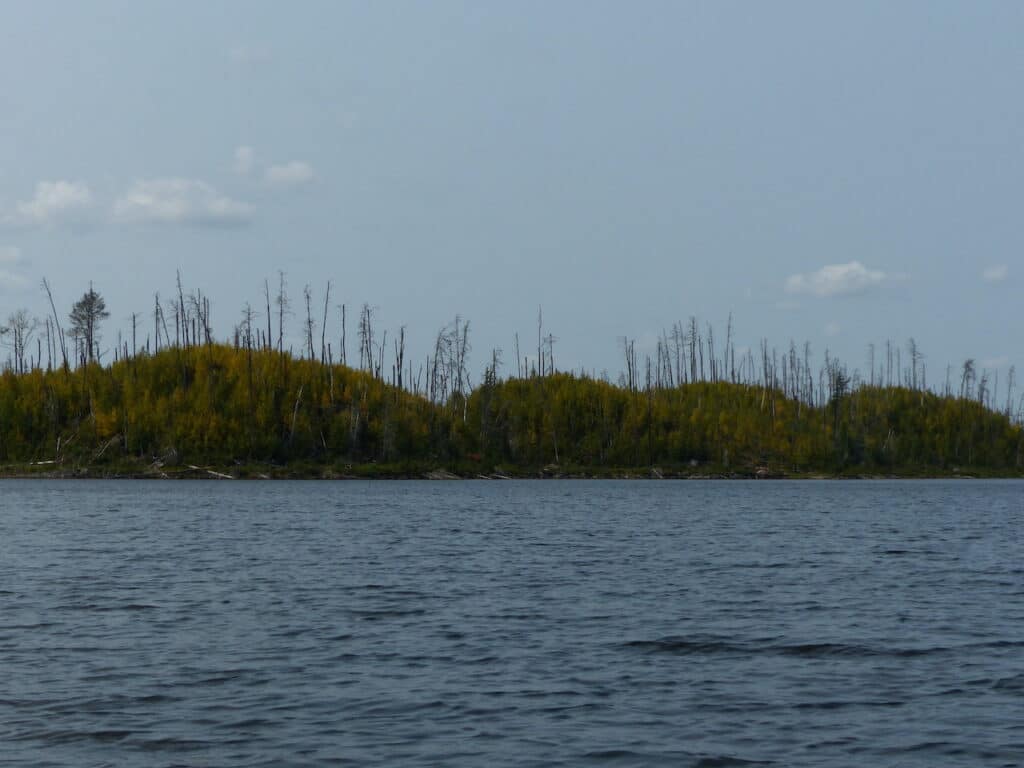
“A short paddle to a totally burned over area across from our campsite resulted in dense stands of new growth pine and aspen trees, purple expanses of flaming fire weed and numerous varieties of other weeds already thick and chest high. We walked up a hillside through abundant patches of sweet raspberries ripe for the picking. Rocks were burned black and dead trees standing, leaning and lying in tangles of destruction. The whole scene left a haunting impression of a panorama sprinkled with splashes of beauty and glimpses of a hopeful future for forest growing toward maturity, but certainly not in our lifetimes.”
– Larry Christianson
July 2015
“In exploring a large shelf rock on Lake Three, we discovered wildflowers galore, tangles of burned trees lying haphazardly on the ground, thousands of young aspens that sprouted after the burn and thick clusters of little pine saplings. And the bonanza of blueberries thriving in the fourth growing season following the forest fire. Lush carpets of little green bushes hugging the ground and teeming with beautiful berries in a spectrum of colors from white to green to lavender and finally to a fully ripe, deep blue. Picking was easy – from hand to mouth to taste buds for a natural sweet delight.”
– Larry Christianson
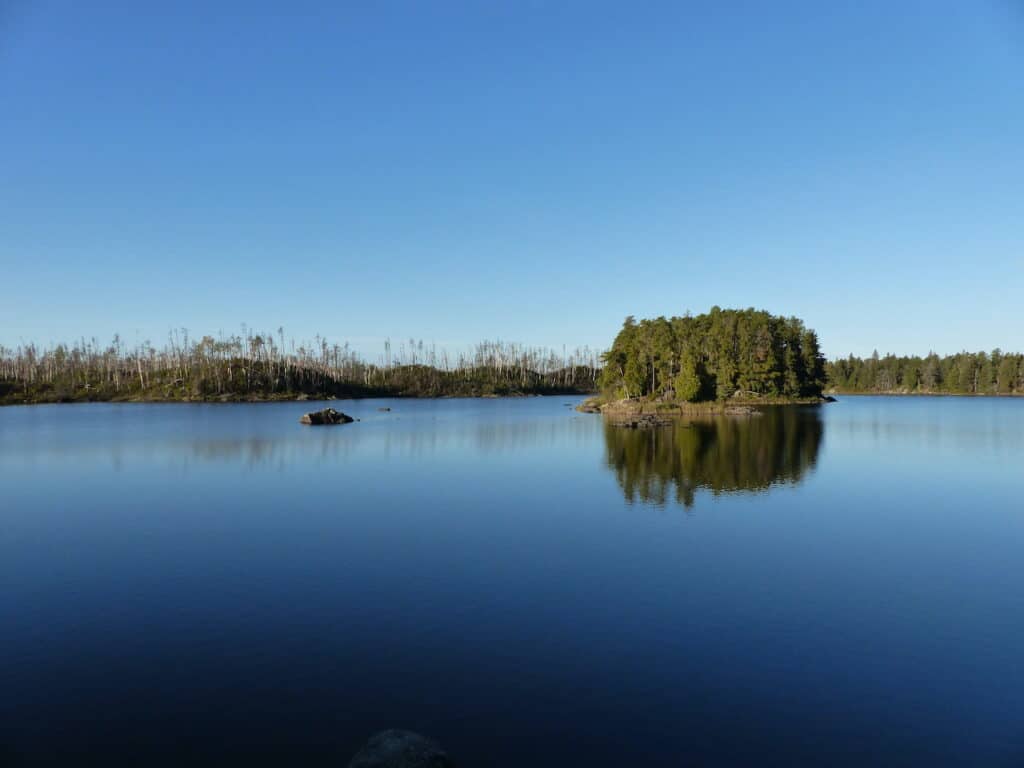
September 2016
“While base camping on Lake Three we paddled and portaged over to Horseshoe Lake on an observation tour of the totally burned area five years now after the fire. Like a peaceful desolation with dead trees both standing and fallen along the lakeshore and well into the forest that is making an impressive comeback with extensive young evergreens and aspens. A forlorn feeling mingled with hopeful renewal. Not a soul in sight with three of the four campsites closed in various states of devastation.”
– Larry Christianson
July 2017
“Paddling along the east shoreline of Lake Three we explored campsites. The first two open and not touched by fire. The next two going south had been so burned out we couldn’t find their locations. Large stands of new growth aspen covered the hillsides, along with hundreds of evergreens now 8 to 10 feet tall, offering a start contrast to the remaining burned snags and tangled downfall. Another day we paddled across the lake to our old high camp on the west shore, resulting in Norma finding her “heart log” for a special five years after photo opportunity.”
– Larry Christianson
September 2017
“We paddled north through the channel on the east side of Lake Three for post-fire sightseeing, and a lunch picnic at the location in a cluster of small cedar trees where we spent the night in the woods back six years during our escape.
“The memories were still very fresh for both of us: smoke swirling with the wind, flocks of migrating geese frantic with wild honking, a full moon orange and spooky slipping in and out of clouds, sitting there in our camp chairs passing a very long and tense night.”
– Larry Christianson
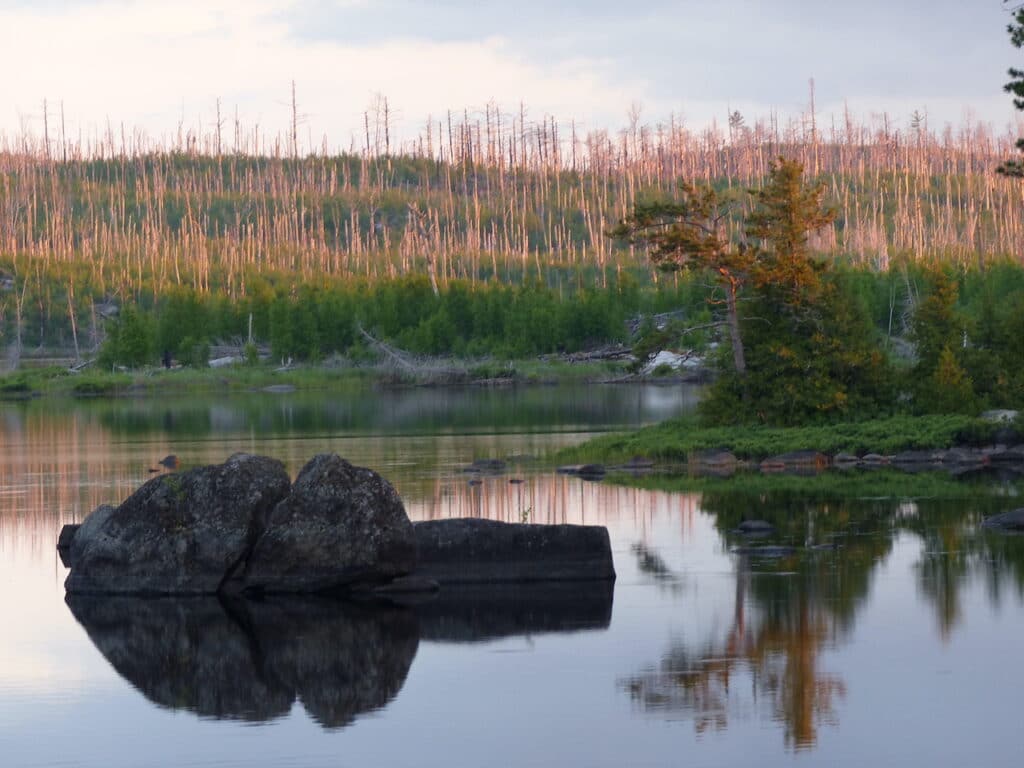
July 2019
“With plenty of aspen, the beavers are back building a lodge across from our campsite on Lake Three! Watched one come ashore in the channel and others hauling branches at dusk. Bald eagles have been present ever since the fire when their nest was spared. Raspberries and blueberries are plentiful.”
– Norma Christianson
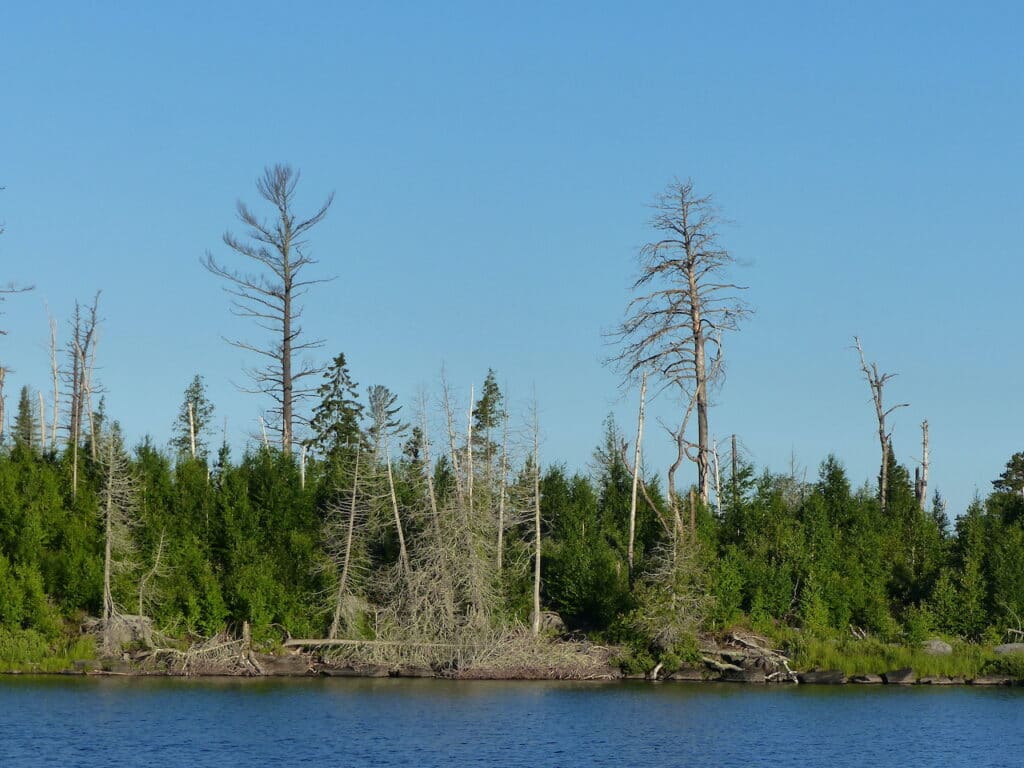
2020
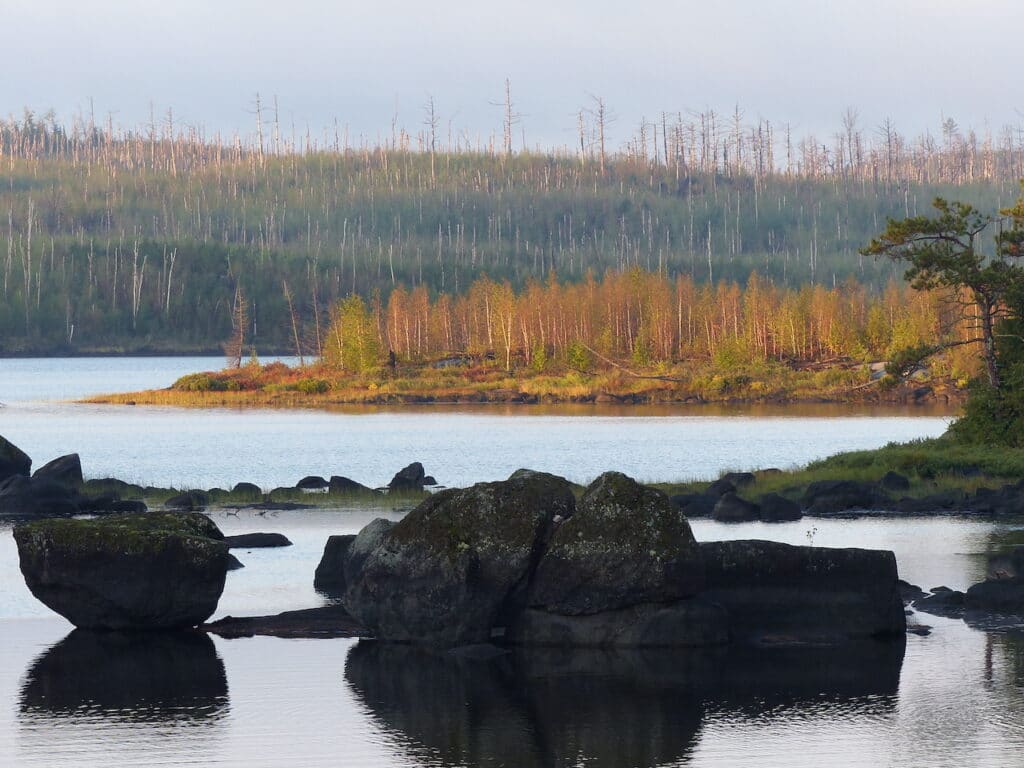
September 2021
“It was very interesting to observe how the drought has impacted the new growth from the fire. Nine steps forward, one step back! Many rocks are exposed again. Aspen are stressed. Beaver activity in many places, including in front of our camp!”
– Norma Christianson
Another perspective
Quetico Superior Wilderness News reader Evan Koch also shared photos of areas burned near Lake Three, from a trip in fall 2020. “Seeing open terrain where we’re accustomed to a green wall was surreal,” he said.
